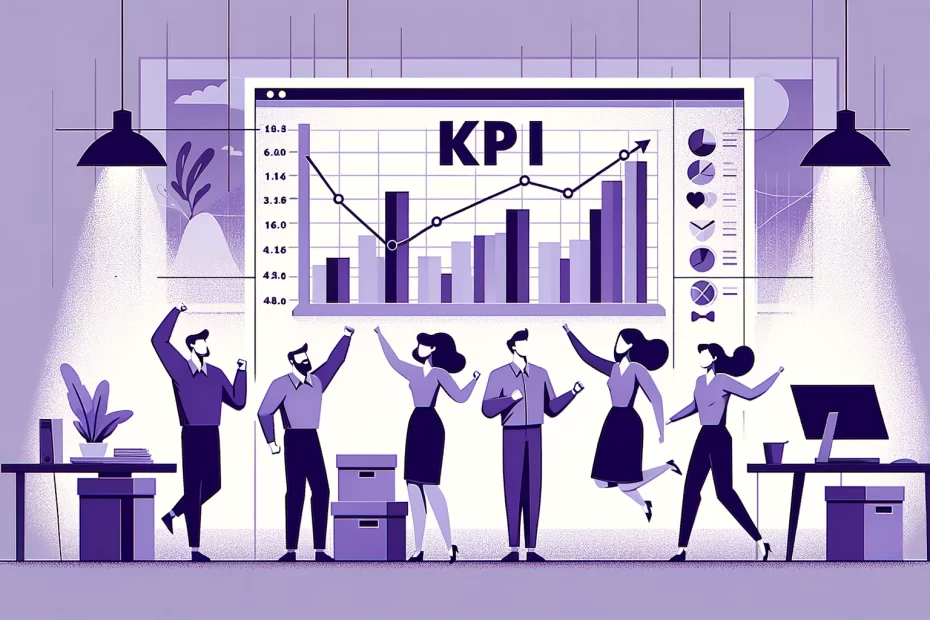Measuring the success of a company goes beyond just having a solid business plan or a great product. The satisfaction of employees and the overall company culture play a crucial role in achieving business success.
Statistics do show that companies with highly engaged workforces are reported to be 21% more profitable, and engaged teams have 10% higher customer ratings, 21% greater profitability, and 17% higher productivity.
To accurately measure employee satisfaction and company culture, it is important to use Key Performance Indicators (KPIs). KPIs provide measurable insights into employee satisfaction and help track performance over time. Some core KPIs for measuring work culture include eNPS (Employee Net Promoter Score), ESI (Employee Satisfaction Index), and employee turnover rate.
Key Takeaways:
- Optimizing business success requires measuring employee satisfaction and company culture.
- Key Performance Indicators (KPIs) provide measurable insights into work culture.
- eNPS, ESI, and employee turnover rate are core KPIs for measuring work culture.
- KPIs help track performance and identify areas for improvement.
- Using KPIs can lead to higher employee engagement and business growth.

The Importance of Using KPIs to Measure Success
When it comes to improving company culture and optimizing business success, relying on assumptions and surface-level observations simply won’t cut it. That’s where Key Performance Indicators (KPIs) come in. By using KPIs, companies can objectively measure employee satisfaction and track the performance of their company culture. These metrics provide valuable insights into the success of people and culture, enabling organizations to make data-driven decisions and compare their performance to industry benchmarks.
By combining KPIs with open-ended feedback, companies can gain a comprehensive understanding of their culture’s strengths and areas for improvement. This approach allows for a more holistic assessment of employee satisfaction, engagement, and overall company culture, enabling companies to develop effective strategies for culture optimization.
Here are some key reasons why using KPIs to measure success is essential:
- KPIs provide an objective way to assess employee satisfaction and the quality of company culture.
- By benchmarking against industry standards, companies can gain insights into their performance relative to competitors.
- KPIs combined with open-ended feedback can uncover valuable insights and shed light on the underlying drivers of employee satisfaction.
- Using KPIs can help organizations identify areas for improvement and develop culture optimization strategies.
Ultimately, KPIs serve as a powerful tool for companies seeking to improve their culture, enhance employee satisfaction, and drive overall business success.
Employee Net Promoter Score (eNPS)
The Employee Net Promoter Score (eNPS) is a powerful metric that enables companies to gauge the enthusiasm of their employees and their likelihood to recommend the company to others. It measures employee satisfaction and helps assess the quality of the company’s culture. Companies with high eNPS scores often have positive work environments and engaged employees, which are vital for sustaining business success.
By calculating the eNPS, companies can identify three categories of employees:
- Promoters: These are highly satisfied employees who actively promote the company and are likely to recommend it to others.
- Passives: These employees may be content but are less likely to advocate for the company.
- Detractors: These employees are dissatisfied and are more likely to speak negatively about the company.
Tracking the eNPS over time allows companies to measure the impact of culture improvement efforts and identify specific events or factors that affect employee satisfaction. It provides valuable insights for making informed decisions and implementing targeted strategies to enhance the company’s culture and overall employee experience. However, the limitations of eNPS is that they are only snapshots and could vary greatly from one point to the next.
Employee Satisfaction Index (ESI)
The Employee Satisfaction Index (ESI) is a comprehensive metric that assesses the overall satisfaction of employees within an organization. It takes into account various factors such as workplace satisfaction, meeting expectations, and the proximity to the ideal workplace environment. Employees are asked to rate their satisfaction on a scale of 1-10 for each indicator, providing valuable insights into their level of contentment and engagement.
ESI offers a holistic view of employee satisfaction, helping companies track progress over time and compare their results with industry benchmarks. By regularly monitoring ESI scores, organizations can identify areas of improvement and implement targeted strategies to enhance employee satisfaction and overall company culture.
By investing in employee satisfaction and regularly evaluating the ESI, companies can improve workplace morale, increase productivity, and reduce turnover rates. It enables organizations to identify the drivers of employee satisfaction and take proactive steps to address any issues or concerns, ultimately fostering a culture that values and nurtures its employees.
Sample ESI Ratings Scale:
| Indicator | Rating Scale | Interpretation |
|---|---|---|
| Workplace Satisfaction | 1-10 | 1-3: Very Dissatisfied 4-6: Neutral 7-10: Very Satisfied |
| Meeting Expectations | 1-10 | 1-3: Not Meeting Expectations 4-6: Meeting Expectations 7-10: Exceeding Expectations |
| Proximity to Ideal Workplace | 1-10 | 1-3: Far from Ideal 4-6: Moderately Close to Ideal 7-10: Very Close to Ideal |
Employee Turnover Rate
Measuring the employee turnover rate is a critical Key Performance Indicator (KPI) for evaluating the success of a company’s culture. High turnover rates indicate dissatisfaction among employees and highlight the need for culture improvement. Calculating the turnover rate involves dividing the number of employees who left during a specific time period by the average number of employees in that same period. This KPI not only provides insight into employee satisfaction but also sheds light on the financial costs and loss of knowledge that come with high turnover.
Retention Rate
Retaining employees is a key factor in enhancing workplace culture performance. The retention rate measures the percentage of employees who choose to stay with the company for a specified period, typically the first 100 days of employment. A high retention rate indicates that employees are satisfied and engaged with the company’s culture, leading to improved overall performance.
Monitoring the retention rate provides valuable insights into the effectiveness of culture enhancement efforts and helps identify areas for improvement. By tracking retention rates over time, companies can determine the impact of their culture optimization strategies and make data-driven decisions to enhance employee satisfaction and retention.
| Benefits of a High Retention Rate | Challenges of a Low Retention Rate |
|---|---|
| Higher employee morale and satisfactionReduced recruitment and training costsEnhanced team collaboration and productivityConsistency in delivering high-quality work | Increased recruitment and onboarding expensesLoss of valuable knowledge and experienceDecreased team stability and productivityNegative impact on company culture and morale |
Improving retention rates requires a comprehensive approach that focuses on creating a positive work environment, fostering meaningful relationships, and providing growth opportunities. By prioritizing employee development, recognizing achievements, and maintaining open lines of communication, companies can enhance workplace culture and increase employee retention.
We all need people who will give us feedback. That’s how we improve.
Bill Gates

Improving Employee Satisfaction Through a Culture of Feedback
Creating a culture of feedback is essential for improving employee satisfaction and company culture. By establishing regular opportunities for employee surveys and feedback collection, organizations can gather valuable insights into areas of improvement and provide employees with a sense of value and being heard. This culture optimization strategy allows companies to address pain points, recognize achievements, and foster healthier communication within the organization.
Benefits of a Culture of Feedback
- Insights into employee sentiment: Employee surveys and feedback collection provide organizations with valuable insights into how employees are experiencing company culture and identify areas for improvement.
- Increased employee engagement: By valuing employee feedback and making necessary changes based on their input, organizations can boost employee engagement and job satisfaction.
- Improved communication: A culture of feedback encourages open and transparent communication channels, allowing for better collaboration and teamwork within the organization.
- Identification of pain points: Through feedback collection, organizations can identify pain points and address them promptly, leading to improved employee satisfaction and productivity.
Implementing effective culture assessment methods, such as regular employee surveys or pulse checks, provides organizations with valuable data to track employee satisfaction and identify trends or patterns over time. By analyzing this data, organizations can tailor their culture optimization strategies to address areas for improvement and enhance employee satisfaction and overall company culture. Regular feedback also fosters a sense of empowerment and involvement among employees, as they see their input being valued and acted upon.
Fostering a culture of feedback requires commitment and follow-through from leadership. Organizations should ensure that feedback channels are easily accessible, anonymous if needed, and that results are regularly communicated back to employees along with any actions taken based on feedback. This demonstrates that the organization is listening and values employee voices, further contributing to a positive work culture.
| Benefits of a Culture of Feedback | Implementation Steps |
|---|---|
| Insights into employee sentiment | Establish regular employee surveys |
| Increased employee engagement | Create anonymous feedback channels |
| Improved communication | Communicate survey results and actions taken |
| Identification of pain points | Address feedback promptly and transparently |
Understanding Key Performance Indicators (KPIs) in Company Culture
Key Performance Indicators (KPIs) are integral in evaluating the progress and success of company culture. These measurable values provide insights into the alignment of organizational performance with strategic objectives. Choosing the right KPIs is crucial for effectively assessing and improving workplace culture, as not all metrics are KPIs. Careful consideration should be given to selecting workplace culture metrics that align with the company’s goals and are easily quantifiable.
Choosing and Tracking KPIs for Organizational Culture
Selecting and tracking the right Key Performance Indicators (KPIs) is crucial for improving employee satisfaction and driving business success. To effectively assess and optimize company culture, KPIs should be aligned with the company’s strategic goals, measurable, and easily understood.
Avoid common mistakes, such as choosing KPIs based on convenience rather than strategy, by carefully considering the specific metrics that provide meaningful insights into your organization’s culture. By understanding the unique needs and dynamics of your company, you can identify the KPIs that truly reflect your culture optimization strategies.
Assigning responsibility for each KPI is essential for creating a culture of monitoring and improvement. By clearly defining who is accountable for tracking and reporting on each metric, you ensure that the necessary data is consistently collected and analyzed. This allows for a comprehensive assessment of your organization’s culture, enabling data-driven decision-making.
Regular Monitoring and Reporting
Regular monitoring and reporting on KPIs are critical steps in assessing the effectiveness of your culture optimization strategies. By consistently tracking the selected metrics, you can identify trends, patterns, and areas of improvement over time. This ongoing monitoring provides valuable insights into the impact of initiatives designed to enhance your company culture.
Fostering a Performance Management System
Creating a performance management system that encourages a data-driven approach strengthens the culture of monitoring and improvement. By integrating KPIs into performance evaluations and goal-setting processes, you align individual and team performance with the desired cultural outcomes. This ensures that culture assessment is embedded within the overall performance management framework of the organization.
By choosing and tracking the right KPIs for your organizational culture, you can effectively assess the impact of your culture optimization strategies. With regular monitoring, reporting, and a performance management system in place, you will have the tools and insights needed to drive continuous improvement and enhance employee satisfaction, leading to overall business success.
Wrapping it Up…
Leveraging workplace culture KPIs is essential for optimizing business success and enhancing employee engagement. By using metrics such as eNPS, ESI, employee turnover rate, and retention rate, companies can effectively track and improve their company culture. These KPIs provide valuable insights into employee satisfaction and help identify areas for improvement.
Creating a culture of feedback is crucial for enhancing employee satisfaction and driving business growth. Regular employee surveys and feedback collection foster open communication, allowing companies to address pain points, recognize achievements, and make data-driven decisions. By selecting the right KPIs and establishing a culture of monitoring and improvement, companies can drive higher employee satisfaction and better performance.
To further enhance the effectiveness of KPI measurement and culture improvement efforts, companies can utilize employee engagement platforms and culture optimization strategies. These platforms provide valuable tools for monitoring KPIs, collecting feedback, and fostering employee engagement. By leveraging these resources, companies can create a positive work environment, drive employee satisfaction, and ultimately achieve long-term business growth.
FAQ
Why is it important to use KPIs to measure company culture?
Measuring company culture is crucial for enhancing employee satisfaction and driving business success. KPIs provide quantifiable insights into employee satisfaction and help track performance over time, ensuring alignment with strategic objectives.
What are some key KPIs for measuring work culture?
Some key KPIs for measuring work culture include eNPS (Employee Net Promoter Score), ESI (Employee Satisfaction Index), employee turnover rate, and retention rate. These metrics provide valuable insights into employee enthusiasm, overall satisfaction, and the impact of culture improvement efforts.
What is eNPS and why is it important?
eNPS, or Employee Net Promoter Score, measures employee enthusiasm about working for a company and their likelihood to recommend the company to others. It helps assess overall employee satisfaction and identifies promoters, passives, and detractors within the organization.
How can Employee Satisfaction Index (ESI) improve employee satisfaction?
The Employee Satisfaction Index (ESI) assesses employees’ satisfaction with workplace conditions, meeting expectations, and proximity to the ideal workplace. By tracking ESI over time, companies can identify areas for improvement, compare with industry benchmarks, and evaluate the impact of specific events on employee satisfaction.
Why is employee turnover rate an important KPI for measuring company culture?
Employee turnover rate reflects employee dissatisfaction and the need for culture improvement. High turnover rates result in financial costs and the loss of valuable knowledge. Calculating the employee turnover rate helps identify areas for improvement and track the effectiveness of culture enhancement efforts.
How does the retention rate impact organizational culture?
The retention rate measures the number of employees who decide to stay with the company for a defined period. A high retention rate indicates employee satisfaction and engagement with the company’s culture. Monitoring retention rates helps identify areas for improvement and track the effectiveness of culture enhancement efforts.
How can a culture of feedback improve employee satisfaction?
Fostering a culture of feedback allows companies to address pain points, recognize achievements, and create healthier communication within the organization. Regular employee surveys and feedback collection provide valuable insights into areas of improvement and make employees feel valued and heard.
What are Key Performance Indicators (KPIs) in company culture?
Key Performance Indicators (KPIs) in company culture are measurable values indicating progress towards specific goals. They help drive organizational performance, ensure alignment with strategic objectives, and provide an objective way to track performance and compare with industry benchmarks.
How should companies choose and track KPIs for organizational culture?
Companies should select KPIs aligned with their strategic goals, easily quantifiable, and understood by all stakeholders. It is important to avoid common mistakes like choosing KPIs based on convenience rather than strategy. Regular monitoring, reporting, and fostering a performance management system that encourages data-driven decision-making are essential to track KPIs effectively.
How can leveraging workplace culture KPIs optimize business success?
Leveraging workplace culture KPIs, such as eNPS, ESI, employee turnover rate, and retention rate, allows companies to track and improve their company culture. By enhancing employee satisfaction and engagement, businesses can drive better performance and ultimately achieve business growth.

